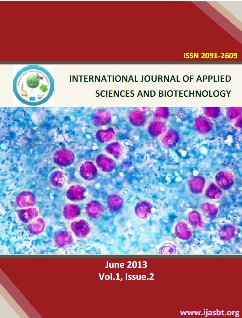Zoonotic aspects of cryptosporidiosis in Nepal
DOI:
https://doi.org/10.3126/ijasbt.v1i2.7959Keywords:
Cryptosporidium, immune-suppression, zoonosisAbstract
Cryptosporidiosis is a common protozoal cause of diarrhea in humans and animals in Nepal, acquired by ingestion of oocysts that were excreted in the feces of infected individuals. Contaminated water represents the major source of Cryptosporidium infections for humans and can be transmitted from person-to-person, from animal-to-person, animal-to-animal, by ingestion of contaminated water and food or by contact with contaminated surfaces. Being highly resistant to environmental and chemical processes and representing the only group of pathogen surviving chlorination, it has no effective chemotherapy identified for the treatment which makes cryptosporidiosis a debilitating and persistent disease with high potential of transmission among immune-compromised ones like children and AIDS patients. Ghimire et. al.,(2010) and Feng et. al., (2012) have mentioned potential transmission of the oocyst among humans and animals in Nepal through common niche like river water, tap water sources and also from wild animals through the interaction on buffer zones. Studies have shown prevalence rate of 16 % in Children (Dhakal et. al., 2004), 11% in HIV infected patients (Basnet et. al., 2010); 14% in Calves, 19% in buffaloes and 12.5% in swamp deer in Nepal (Feng et. al., 2012). The persistent shedding of oocysts by reservoir hosts like calves, kids, poultry and wild animals like deer and monkeys possess great threat to the transmission to general public. The epidemiological studies of cryptosporidium and the knowledge of the pattern of the disease outbreak can guide therapy and effective preventive measures against this disease.
DOI: http://dx.doi.org/10.3126/ijasbt.v1i2.7959
Int J Appl Sci Biotechnol, Vol. 1(2): 21-26




